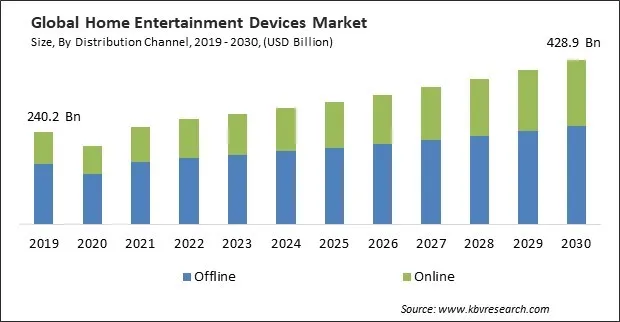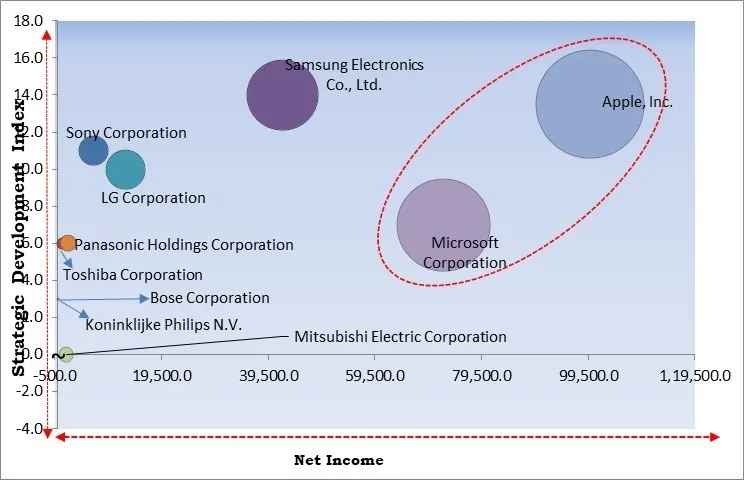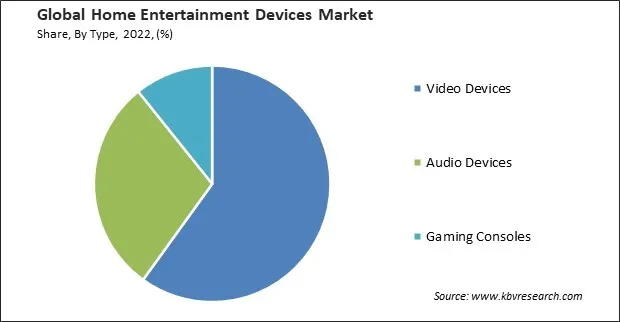The Global Home Entertainment Devices Market size is expected to reach $428.9 billion by 2030, rising at a market growth of 5.8% CAGR during the forecast period. In the year 2022, the market attained a volume of 5,36,540.5 thousand units experiencing a growth of 6.1% (2019-2022).
The popularity of gaming consoles, including systems like PlayStation, Xbox, and Nintendo Switch, has been a significant driver for the market. Consequently, the gaming consoles segment would account for nearly 12% of the total market share by 2030. These Gaming consoles offer immersive gaming experiences, combining high-quality graphics, advanced gameplay, and innovative features. Consumers seeking diverse and high-performance gaming have driven the sales and adoption of these consoles.

The major strategies followed by the market participants are Product Launches as the key developmental strategy to keep pace with the changing demands of end users. For instance, in October, 2023, Sony Corporation introduced Pulse Explorer wireless earbuds. The earbuds have lossless PlayStation link technology and ultra-low latency mode along with AI-powered noise cancellation. Moreover, in September,2023, LG Corporation unveiled LG MAGNIT, a Micro LED residential display. The display comes in a 118-inch size and has a 0.6 mm 4K resolution.
Based on the Analysis presented in the KBV Cardinal matrix; Apple, Inc. and Microsoft Corporation are the forerunners in the Market. In June, 2023, Apple, Inc. announced the launch of Apple Vision Pro, a spatial computer that smoothly integrates digital content with the physical world. The Vision Pro makes a three-dimensional user interface that can be controlled by eyes, hands, and voice. Companies such as Samsung Electronics Co., Ltd., LG Corporation and Sony Corporation are some of the key innovators in Market.

Streaming services offer a vast library of on-demand content, allowing consumers to conveniently watch movies, TV shows, documentaries, and original programming. Installing streaming apps directly into smart TVs has become a standard feature. Smart TVs provide a seamless experience, allowing users to access popular streaming services without additional devices. The convenience of having these apps built into the TV contributes to the popularity of smart TVs. Furthermore, the demand for better picture quality has led to increased adoption of 4K Ultra HD and High Dynamic Range (HDR) technologies. Smart TVs and streaming devices with these capabilities offer sharper images, vibrant colors, and improved contrast, enhancing the overall viewing experience. These aspects will boost the demand for these devices in the coming years.
Consumers are showing a strong preference for high-resolution displays, such as 4K and 8K technologies. These advancements in display technology have transformed the visual experience by offering superior image quality, sharper details, and more vibrant colors. The demand for larger screens with higher resolutions has been a significant factor propelling the demand for televisions, monitors, and display screens. Moreover, the demand for big-screen televisions and high-definition monitors has steadily risen. Bigger screens offer a more immersive viewing experience, especially with higher resolutions, contributing to market growth. These aspects will propel the demand for these devices in the coming years.
Larger, established brands often hold a significant market share, benefiting from consumer trust and recognition. This can make it difficult for newer or lesser-known brands to compete effectively. Many consumers tend to stick with brands they trust, making it challenging for new entrants to attract and retain customers who are already loyal to established brands. Additionally, access to retail channels and distribution networks can challenge newer companies. Established brands often have strong relationships with retailers, making it difficult for new entrants to secure prime shelf space or online visibility. Hence, these factors can reduce the demand in the market.
On the basis of mode of connectivity, the market is divided into wireless and wired. In 2022, the wireless segment witnessed a substantial revenue share in the market. Wireless technology offers unparalleled convenience, allowing users to connect devices without the constraints of cables. This has led to the increased adoption of wireless speakers, headphones, and sound systems, providing users with flexibility in their home entertainment setup and enabling them to enjoy high-quality audio without the limitations of physical connections. Owing to these aspects, the segment will witness increased demand in the future.
Based on type, the market is segmented into video devices, audio devices, and gaming consoles. In 2022, the audio devices segment garnered a significant revenue share in the market. The development of advanced sound technologies, such as Dolby Atmos, DTS:X, and other immersive audio formats, has significantly enhanced the quality of sound reproduction. These systems provide users with an immersive cinematic experience by delivering high-quality sound, making them a sought-after addition to home entertainment setups. These aspects will pose lucrative growth prospects for the segment.

On the basis of distribution channel, the market is segmented into offline and online. In 2022, the online segment witnessed a substantial revenue share in the market. Consumers increasingly prefer the convenience of accessing content online, anytime and anywhere, contributing to the expansion of the online home entertainment sector. This trend is further fueled by the proliferation of high-speed internet connectivity, the availability of smart devices, and the growing popularity of smart TVs. These factors will boost the demand in the segment.
| Report Attribute | Details |
|---|---|
| Market size value in 2022 | USD 274.7 Billion |
| Market size forecast in 2030 | USD 428.9 Billion |
| Base Year | 2022 |
| Historical Period | 2019 to 2021 |
| Forecast Period | 2023 to 2030 |
| Revenue Growth Rate | CAGR of 5.8% from 2023 to 2030 |
| Number of Pages | 587 |
| Number of Table | 1114 |
| Quantitative Data | Volume in Thousand Units, Revenue in USD Billion, and CAGR from 2019 to 2030 |
| Report coverage | Market Trends, Revenue Estimation and Forecast, Segmentation Analysis, Regional and Country Breakdown, Competitive Landscape, Porter’s 5 Forces Analysis, Company Profiling, Companies Strategic Developments, SWOT Analysis, Winning Imperatives |
| Segments covered | Type, Mode Of Connectivity, Distribution Channel, Region |
| Country scope |
|
| Companies Included | Samsung Electronics Co., Ltd. (Samsung Group), LG Corporation, Sony Corporation, Toshiba Corporation, Apple, Inc., Panasonic Holdings Corporation, Microsoft Corporation, Koninklijke Philips N.V., Bose Corporation and Mitsubishi Electric Corporation |
| Growth Drivers |
|
| Restraints |
|
By region, the market is segmented into North America, Europe, Asia Pacific, and LAMEA. In 2022, the Asia Pacific segment acquired the highest revenue share in the market. The region has embraced technological advancements swiftly. Consumers in Asia Pacific countries are willing to adopt the latest innovations in the home entertainment segment. Gaming has gained substantial popularity in the Asia Pacific region. Countries like Japan, China, and South Korea have a strong gaming culture, and the demand for gaming consoles and accessories has surged. These factors will pose lucrative growth prospects for the segment.
Free Valuable Insights: Global Home Entertainment Devices Market size to reach USD 428.9 Billion by 2030
The market research report covers the analysis of key stake holders of the market. Key companies profiled in the report include Samsung Electronics Co., Ltd. (Samsung Group), LG Corporation, Sony Corporation, Toshiba Corporation, Apple, Inc., Panasonic Holdings Corporation, Microsoft Corporation, Koninklijke Philips N.V., Bose Corporation and Mitsubishi Electric Corporation
By Distribution Channel (Volume, Thousand Units, Revenue, USD Billion/Million, 2019-30)
By Mode Of Connectivity (Volume, Thousand Units, Revenue, USD Billion/Million, 2019-30)
By Type (Volume, Thousand Units, Revenue, USD Billion/Million, 2019-30)
By Geography (Volume, Thousand Units, Revenue, USD Billion/Million, 2019-30)


This Market size is expected to reach $428.9 billion by 2030.
Rise of streaming services worldwide are driving the Market in coming years, however, High market saturation and competition restraints the growth of the Market.
Samsung Electronics Co., Ltd. (Samsung Group), LG Corporation, Sony Corporation, Toshiba Corporation, Apple, Inc., Panasonic Holdings Corporation, Microsoft Corporation, Koninklijke Philips N.V., Bose Corporation and Mitsubishi Electric Corporation
In the year 2022, the market attained a volume of 5,36,540.5 thousand units experiencing a growth of 6.1% (2019-2022).
The Wired segment is generating the highest revenue in the Market by Mode Of Connectivity in 2022; thereby, achieving a market value of $278 billion by 2030.
The Asia Pacific region dominated the Market by Region in 2022, and would continue to be a dominant market till 2030; thereby, achieving a market value of $161 billion by 2030.
Our team of dedicated experts can provide you with attractive expansion opportunities for your business.

